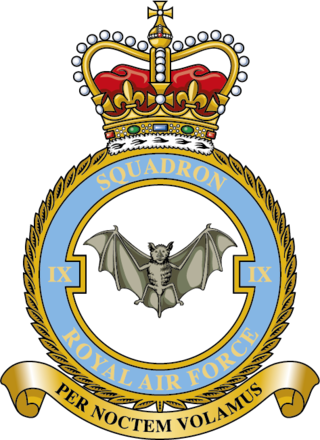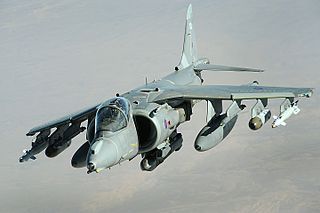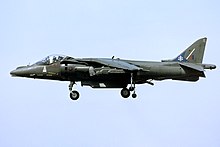
The SEPECAT Jaguar is an Anglo-French jet attack aircraft originally used by the British Royal Air Force and the French Air Force in the close air support and nuclear strike role. It is still in service with the Indian Air Force.

The Panavia Tornado Air Defence Variant (ADV) was a long-range, twin-engine swing-wing interceptor aircraft developed by the European Panavia Aircraft GmbH consortium. It was a specialised derivative of the multirole Panavia Tornado.

Number 17 Squadron, currently No. 17 Test and Evaluation Squadron (TES), is a squadron of the Royal Air Force. It was reformed on 12 April 2013 at Edwards Air Force Base, California, as the Operational Evaluation Unit (OEU) for the Lockheed Martin F-35B Lightning.

Royal Air Force Coningsby or RAF Coningsby, is a Royal Air Force (RAF) station located 13.7 kilometres (8.5 mi) south-west of Horncastle, and 15.8 kilometres (9.8 mi) north-west of Boston, in the East Lindsey district of Lincolnshire, England. It is a Main Operating Base of the RAF and home to three front-line Eurofighter Typhoon FGR4 units, No. 3 Squadron, No. 11 Squadron and No. 12 Squadron. In support of front-line units, No. 29 Squadron is the Typhoon Operational Conversion Unit and No. 41 Squadron is the Typhoon Test and Evaluation Squadron. Coningsby is also the home of the Battle of Britain Memorial Flight (BBMF) which operates a variety of historic RAF aircraft.

Number 9 Squadron is the oldest dedicated Bomber Squadron of the Royal Air Force. Formed in December 1914, it saw service throughout the First World War, including at the Somme and Passchendaele. During the Second World War, No. IX (B) Squadron was one of two Avro Lancaster units specialising in heavy precision bombing and sank the battleship Tirpitz on 12 November 1944 in Operation Catechism. Between 1962 and April 1982, the squadron flew the Avro Vulcan B.2 as part of the V-Force. In June 1982, it became the first front-line squadron in the world to operate the Panavia Tornado GR.1. In May 1998, No. IX (B) Squadron received the RAF's first Tornado GR.4, which it operated until reequipping with the Eurofighter Typhoon FGR.4 at its present home base of RAF Lossiemouth on 1 April 2019.

Number 6 Squadron of the Royal Air Force operates the Eurofighter Typhoon FGR.4 at RAF Lossiemouth. It was previously equipped with the SEPECAT Jaguar GR.3 in the close air support and tactical reconnaissance roles, and was posted to RAF Coltishall, Norfolk until April 2006, moving to RAF Coningsby until disbanding for the first time in its history on 31 May 2007. The squadron officially reformed as a Typhoon squadron on 6 September 2010. No. 6 Squadron is unique in having two Royal standards, having been awarded its second one by King Abdullah I of Jordan in October 1950 due to its long period of service in the Middle East.

Royal Air Force Brüggen, more commonly known as RAF Brüggen, in Germany was a major Royal Air Force station until 15 June 2001. It was situated next to the village of Elmpt, approximately 43 kilometres (27 mi) west of Düsseldorf on the Dutch-German border. The base was named after the village of Brüggen, the nearest rail depot. Construction began in mid-1952, which involved the clearing of forest and draining of marshland. The station became active in 1953 during the rapid expansion of NATO forces in Europe. The main paint shop situated next to the main runway was responsible for the surface finishing of all aircraft, ground equipment and RAF Regiment Rapier missile systems. In 2002, it was handed over to the British Army and renamed Javelin Barracks.

The British Aerospace Harrier II is a second-generation vertical/short takeoff and landing (V/STOL) jet aircraft used previously by the Royal Air Force (RAF) and, between 2006 and 2010, the Royal Navy (RN). The aircraft was the latest development of the Harrier family, and was derived from the McDonnell Douglas AV-8B Harrier II. Initial deliveries of the Harrier II were designated in service as Harrier GR5; subsequently upgraded airframes were redesignated accordingly as GR7 and GR9.

Holbeach Air Weapons Range is a United Kingdom Ministry of Defence academic air weapons range (AWR) situated between Boston and King's Lynn in the civil parish of Gedney on The Wash, in Lincolnshire, eastern England.

Number 15 Squadron, sometimes written as No. XV Squadron, was a squadron of the Royal Air Force. It most recently operated the Panavia Tornado GR4 from RAF Lossiemouth as No. XV (Reserve) Squadron. It was the RAF's Operational Conversion Unit for the Tornado GR4 which taught pilots and Weapon Systems Officers (WSO) how to fly the aircraft and what tactics to use to best exploit the performance of their aircraft and its weapons.

Royal Air Force Germany, commonly known as RAF Germany, and abbreviated RAFG, is a former command of the Royal Air Force (RAF) and part of British Forces Germany (BFG). It consisted of units located in Germany, initially in what was known as West Germany as part of the British Air Forces of Occupation (BAFO) following the Second World War, and later as part of the RAF's commitment to the defence of Europe during the Cold War. The commander of RAFG doubled as commander of NATO's Second Allied Tactical Air Force (2ATAF). Its motto was 'Keepers of the Peace'.

Royal Air Force Laarbruch, more commonly known as RAF Laarbruch ICAO EDUL was a Royal Air Force station, a military airfield, located in Germany on its border with the Netherlands. The Station's motto was Eine feste Burg.
An Operational Evaluation Unit is a type of "reserve" squadron of the Royal Air Force. OEU squadrons are tasked with evaluating an aircraft's weapons, systems and performance. This is to either assist in bringing the aircraft to an operational capability, or to continually assess how to best utilize the aircraft's capability once its in service. An example of such a squadron is No. 17 Squadron of the RAF. The Squadron's role as the F-35B Operation Evaluation Unit is being tasked with introducing the JSF aircraft into service with the Royal Air Force. It is equipped with four F35Bs and currently operates from Edwards Air Force Base in the United States.
899 Naval Air Squadron was a squadron of the Fleet Air Arm of the United Kingdom.
At the end of the Cold War in 1989, the Royal Air Force (RAF) structure was as follows:

Air Marshal Martin Elliot Sampson, is a senior Royal Air Force officer, serving as UK Defence Senior Advisor to the Middle East and North Africa.














